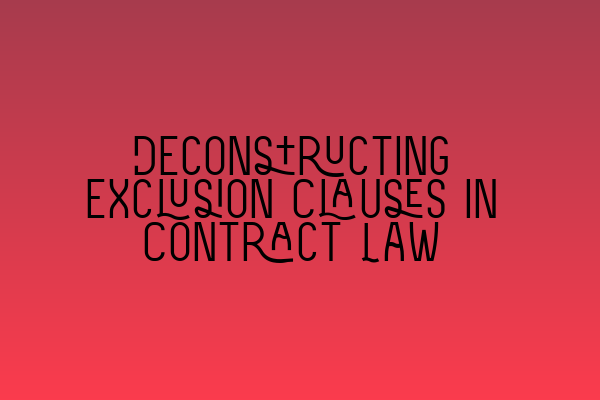Deconstructing Exclusion Clauses in Contract Law
In the world of contract law, exclusion clauses play a crucial role in defining the rights and obligations of parties involved in a contractual agreement. These clauses are used to limit or exclude liability, and understanding their intricacies is essential for both solicitors and their clients.
In this article, we will delve into the world of exclusion clauses, exploring their purpose, types, and interpretation. Whether you’re preparing for the SQE 1 or SQE 2 exams, or simply seeking a deeper understanding of contract law, this post aims to provide valuable insights.
Before we dive in, it’s important to familiarize ourselves with some related topics. If you’re looking for SQE 1 practice exam questions and SQE 1 practice mocks, visit our articles on SQE 1 Practice Exam Questions and SQE 1 Practice Mocks FLK1 FLK2. Additionally, if you’re interested in preparing for the SQE 2 exams, explore our comprehensive SQE 2 Preparation Courses. For more information on SQE 1 preparation courses, click here: SQE 1 Preparation Courses. Finally, if you’re curious about SRA SQE exam dates, head over to our article on SRA SQE Exam Dates.
Now, let’s deconstruct exclusion clauses and understand their significance in contract law.
Purpose of Exclusion Clauses
Exclusion clauses are contractual provisions used to limit or exclude liability for certain types of loss or damage. They act as a shield for parties seeking to protect themselves from potential claims or disputes arising from their contractual obligations. These clauses are often tailored to specific situations and aim to allocate risk between the parties involved.
Types of Exclusion Clauses
There are two primary types of exclusion clauses: exemption clauses and limitation clauses.
Exemption clauses seek to exclude a party’s liability for any breach of contract. They can be general, covering all types of liability, or specific, limiting liability for certain types of losses or damages.
Limitation clauses, on the other hand, aim to limit the liability of a party in the event of a breach of contract. These clauses specify a predetermined amount or percentage of liability that a party is responsible for, regardless of the actual loss or damage suffered.
Interpretation of Exclusion Clauses
When interpreting exclusion clauses, the courts adopt a strict approach. As a general rule, any ambiguity in the wording of an exclusion clause will be construed against the party seeking to rely on it. This means that the party seeking to exclude liability must ensure that the language used is clear, precise, and unambiguous.
The courts also take into account the contra proferentem rule, which states that any ambiguities or uncertainties in an exclusion clause should be interpreted in favor of the party that did not draft or propose the clause. This helps to protect the party who may be at a disadvantage due to the clause’s inclusion.
It’s important for solicitors to analyze the entire contract, including surrounding circumstances and industry practices, to determine the intent of the parties and interpret exclusion clauses properly.
Cases and Precedents
To gain a deeper understanding of how exclusion clauses are interpreted, it is helpful to review relevant cases and precedents. Some famous cases involving exclusion clauses include White v. John Warwick & Co Ltd [1953], Olley v. Marlborough Court Hotel [1949], and Canada Steamship Lines Ltd v. The King [1952]. These cases highlight the importance of clear, unambiguous language and the courts’ strict approach to interpretation.
Conclusion
In summary, exclusion clauses are vital components of a contract, allowing parties to limit or exclude liability for certain types of loss or damage. Understanding the purpose, types, and interpretation of these clauses is essential in contract law.
If you’re preparing for the SQE exams or seeking a comprehensive understanding of contract law, it’s crucial to have access to valuable resources such as practice exam questions, practice mocks, and preparation courses. Explore our SQE 1 and SQE 2 articles for more information. Don’t forget to check out the SRA SQE exam dates.
Remember, when dealing with exclusion clauses, clarity and precision are key. As a solicitor, it’s important to analyze the entire contract and consider industry practices and precedents to ensure fair interpretation and protection for your clients.
